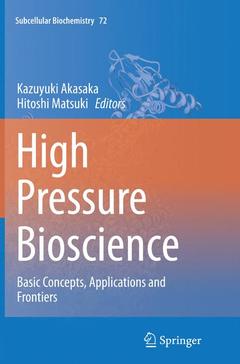High Pressure Bioscience, Softcover reprint of the original 1st ed. 2015 Basic Concepts, Applications and Frontiers Subcellular Biochemistry Series, Vol. 72

This volume covers both the basic concepts and theory of bio-macromolecules under pressure and the various frontiers in high-pressure bioscience and biotechnology. A century has passed since Bridgman discovered the irreversible coagulation of egg white by applying pressure at 700 atmospheres in 1914. Today we are able to monitor pressure-dependent changes in protein structure as a reversible process even at atomic scale with modern spectroscopic techniques. We can study the fluctuating reality of protein structures as designed by nature, which is the basis for all dynamism of life on earth. We are currently facing a new era of high-pressure bioscience, in which pressure is no longer an ?odd? or ?foreign? variable to life, but rather an integrated part of it. Pressure is used as a crucial variable for disclosing the secrets of nature and as a powerful new tool for enhancing certain reactions in bio-macromolecules and even in living cells for our practical and industrial needs. A dramatic advancement of high-pressure bioscience both in the basic and the applied sciences is thus anticipated in near future, for whichsharing the current advanced knowledge on structure and dynamics of bio-macromolecules under pressure among researchers in both fields is crucial.
This book serves as a valuable resource not only for those working directly in a pressure-related field, but also for those working in many other fields of the biosciences. Particularly, the basic part of it is intended to serve as a classical text book on high-pressure bioscience to a wide audience including students and researchers in both basic and applied fields in years to come. Readers can focus on topics of immediate interest first, but may wish to go over other chapters if interest arises in a later occasion.
Part I Why and How Proteins Denature under Pressure?.- 1 Early Days of Pressure Denaturation Studies of Proteins.- 2 Protein Denaturation on p-T Axes - Thermodynamics and Analysis.- 3 Driving Forces in Pressure-induced Protein Transitions.- 4 Why and How Does Pressure Unfold Proteins?.- Part II Volume, Compressibility, Fluctuation and Interaction in Proteins.- 5 Volume and Compressibility of Proteins.- 6 Pressure-Dependent Conformation and Fluctuation in FoldedProtein Molecules.- 7 Water Turns the "Non-Biological" Fluctuation of Proteininto "Biological" One.- 8 Pressure Effects on the Intermolecular Interaction Potentialof Condensed Protein Solutions.- Part III Pressure and Functional Sub-States in Proteins.- 9 High Pressure NMR Methods for Characterizing FunctionalSub-States of Proteins.- 10 High-Pressure NMR Spectroscopy Reveals Functional Sub-Statesof Ubiquitin and Ubiquitin-Like Proteins.- 11 Functional Sub-States of Proteins by Macromolecular Crystallography.- 12 Cavities and Excited States in Proteins.- Part IV Pressure and Protein Folding and Assembly.- 13 Exploring the Protein Folding Pathway with High-Pressure NMR: Steady-State and Kinetic Studies.- 14 Basic Equations in Statics and Kinetics of Protein Polymerization and the Mechanism of the Formation and Dissociation of Amyloid Fibrils Revealed by Pressure Perturbation.- 15 Pressure-Inactivated Virus: a Promising Alternative for Vaccine Production.- Part V Pressure Effects on Biological Membranes.- 16 How Do Membranes Respond to Pressure?.- 17 Pressure Effects on Artificial and Cellular Membranes.- 18 Effects of High Hydrostatic Pressure on Microbial Cell Membranes: Structural and Functional Perspectives.- 19 Homeoviscous Adaptation of Membranes in Archaea.- Part VI Pressure adaptation and tolerance of proteins and living organisms.- 20 Pressure-Dependent Gene Activation in Yeast Cells.- 21 Environmental Adaptation of Dihydrofolate Reductase from Deep-Sea Bacteria.- 22 Moss Spores Can Tolerate Ultra-High Pressure.- Part VII High pressure food processing and pasteurization.- 23 Pressure-Based Strategy for the Inactivation of Spores.- 24 Use of Pressure Activation in Food Quality Improvement.- 25 Use of Pressure for Improving Storage Quality of Fresh-Cut Produce.- 26 Application of High-Pressure Treatment to Enhancement of Functional Components in Agricultural Products and Development of Sterilized Foods.- Part VIII Pressure Effects on Motility, Physiology and Health.- 27 High-Pressure Microscopy for Studying Molecular Motor.- 28 Ion Channels Activated by Mechanical Forcesin Bacterial and Eukaryotic Cells.- 29 Gravitational Effects on Human Physiology.- Part IX Methodology.- 30 High Pressure Small-Angle X-Ray Scattering.- 31 High Pressure Macromolecular Crystallography.- 32 High-Pressure Fluorescence Spectroscopy up to 700 MPa.- 33 High Pressure NMR Spectroscopy.
A first, comprehensive monograph on bioscience and biotechnology under high pressure
Entire field of research from the basic to the application on bio-macromolecular events under high pressure
Serve as a text book for under- and post-graduate students in both basic and applied bioscience
Includes supplementary material: sn.pub/extras
Date de parution : 10-2016
Ouvrage de 730 p.
15.5x23.5 cm
Date de parution : 07-2015
Ouvrage de 730 p.
15.5x23.5 cm



